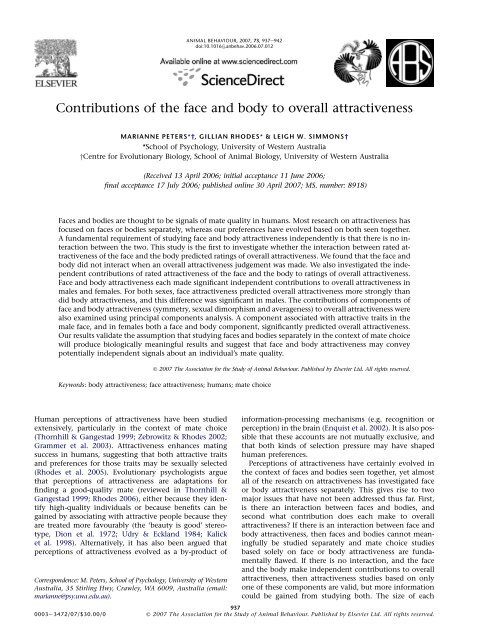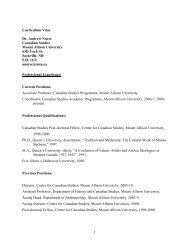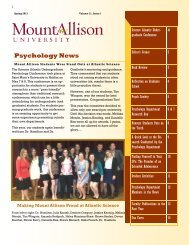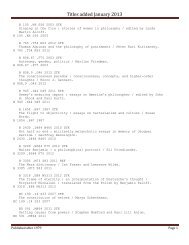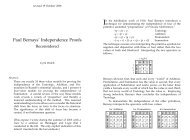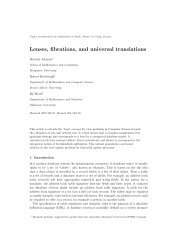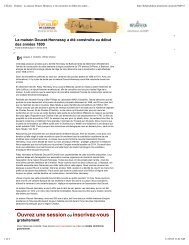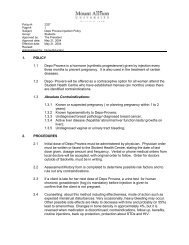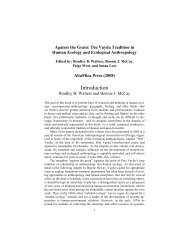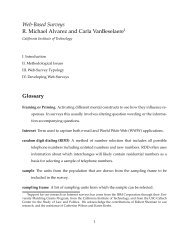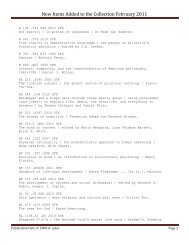Contributions of the face and body to overall attractiveness
Contributions of the face and body to overall attractiveness
Contributions of the face and body to overall attractiveness
Create successful ePaper yourself
Turn your PDF publications into a flip-book with our unique Google optimized e-Paper software.
<strong>Contributions</strong> <strong>of</strong> <strong>the</strong> <strong>face</strong> <strong>and</strong> <strong>body</strong> <strong>to</strong> <strong>overall</strong> <strong>attractiveness</strong><br />
MARIANNE PETERS*†, GILLIAN RHODES* &LEIGHW.SIMMONS†<br />
*School <strong>of</strong> Psychology, University <strong>of</strong> Western Australia<br />
yCentre for Evolutionary Biology, School <strong>of</strong> Animal Biology, University <strong>of</strong> Western Australia<br />
(Received 13 April 2006; initial acceptance 11 June 2006;<br />
final acceptance 17 July 2006; published online 30 April 2007; MS. number: 8918)<br />
Faces <strong>and</strong> bodies are thought <strong>to</strong> be signals <strong>of</strong> mate quality in humans. Most research on <strong>attractiveness</strong> has<br />
focused on <strong>face</strong>s or bodies separately, whereas our preferences have evolved based on both seen <strong>to</strong>ge<strong>the</strong>r.<br />
A fundamental requirement <strong>of</strong> studying <strong>face</strong> <strong>and</strong> <strong>body</strong> <strong>attractiveness</strong> independently is that <strong>the</strong>re is no interaction<br />
between <strong>the</strong> two. This study is <strong>the</strong> first <strong>to</strong> investigate whe<strong>the</strong>r <strong>the</strong> interaction between rated <strong>attractiveness</strong><br />
<strong>of</strong> <strong>the</strong> <strong>face</strong> <strong>and</strong> <strong>the</strong> <strong>body</strong> predicted ratings <strong>of</strong> <strong>overall</strong> <strong>attractiveness</strong>. We found that <strong>the</strong> <strong>face</strong> <strong>and</strong><br />
<strong>body</strong> did not interact when an <strong>overall</strong> <strong>attractiveness</strong> judgement was made. We also investigated <strong>the</strong> independent<br />
contributions <strong>of</strong> rated <strong>attractiveness</strong> <strong>of</strong> <strong>the</strong> <strong>face</strong> <strong>and</strong> <strong>the</strong> <strong>body</strong> <strong>to</strong> ratings <strong>of</strong> <strong>overall</strong> <strong>attractiveness</strong>.<br />
Face <strong>and</strong> <strong>body</strong> <strong>attractiveness</strong> each made significant independent contributions <strong>to</strong> <strong>overall</strong> <strong>attractiveness</strong> in<br />
males <strong>and</strong> females. For both sexes, <strong>face</strong> <strong>attractiveness</strong> predicted <strong>overall</strong> <strong>attractiveness</strong> more strongly than<br />
did <strong>body</strong> <strong>attractiveness</strong>, <strong>and</strong> this difference was significant in males. The contributions <strong>of</strong> components <strong>of</strong><br />
<strong>face</strong> <strong>and</strong> <strong>body</strong> <strong>attractiveness</strong> (symmetry, sexual dimorphism <strong>and</strong> averageness) <strong>to</strong> <strong>overall</strong> <strong>attractiveness</strong> were<br />
also examined using principal components analysis. A component associated with attractive traits in <strong>the</strong><br />
male <strong>face</strong>, <strong>and</strong> in females both a <strong>face</strong> <strong>and</strong> <strong>body</strong> component, significantly predicted <strong>overall</strong> <strong>attractiveness</strong>.<br />
Our results validate <strong>the</strong> assumption that studying <strong>face</strong>s <strong>and</strong> bodies separately in <strong>the</strong> context <strong>of</strong> mate choice<br />
will produce biologically meaningful results <strong>and</strong> suggest that <strong>face</strong> <strong>and</strong> <strong>body</strong> <strong>attractiveness</strong> may convey<br />
potentially independent signals about an individual’s mate quality.<br />
Ó 2007 The Association for <strong>the</strong> Study <strong>of</strong> Animal Behaviour. Published by Elsevier Ltd. All rights reserved.<br />
Keywords: <strong>body</strong> <strong>attractiveness</strong>; <strong>face</strong> <strong>attractiveness</strong>; humans; mate choice<br />
Human perceptions <strong>of</strong> <strong>attractiveness</strong> have been studied<br />
extensively, particularly in <strong>the</strong> context <strong>of</strong> mate choice<br />
(Thornhill & Gangestad 1999; Zebrowitz & Rhodes 2002;<br />
Grammer et al. 2003). Attractiveness enhances mating<br />
success in humans, suggesting that both attractive traits<br />
<strong>and</strong> preferences for those traits may be sexually selected<br />
(Rhodes et al. 2005). Evolutionary psychologists argue<br />
that perceptions <strong>of</strong> <strong>attractiveness</strong> are adaptations for<br />
finding a good-quality mate (reviewed in Thornhill &<br />
Gangestad 1999; Rhodes 2006), ei<strong>the</strong>r because <strong>the</strong>y identify<br />
high-quality individuals or because benefits can be<br />
gained by associating with attractive people because <strong>the</strong>y<br />
are treated more favourably (<strong>the</strong> ‘beauty is good’ stereotype,<br />
Dion et al. 1972; Udry & Eckl<strong>and</strong> 1984; Kalick<br />
et al. 1998). Alternatively, it has also been argued that<br />
perceptions <strong>of</strong> <strong>attractiveness</strong> evolved as a by-product <strong>of</strong><br />
Correspondence: M. Peters, School <strong>of</strong> Psychology, University <strong>of</strong> Western<br />
Australia, 35 Stirling Hwy, Crawley, WA 6009, Australia (email:<br />
marianne@psy.uwa.edu.au).<br />
ANIMAL BEHAVIOUR, 2007, 73, 937e942<br />
doi:10.1016/j.anbehav.2006.07.012<br />
information-processing mechanisms (e.g. recognition or<br />
perception) in <strong>the</strong> brain (Enquist et al. 2002). It is also possible<br />
that <strong>the</strong>se accounts are not mutually exclusive, <strong>and</strong><br />
that both kinds <strong>of</strong> selection pressure may have shaped<br />
human preferences.<br />
Perceptions <strong>of</strong> <strong>attractiveness</strong> have certainly evolved in<br />
<strong>the</strong> context <strong>of</strong> <strong>face</strong>s <strong>and</strong> bodies seen <strong>to</strong>ge<strong>the</strong>r, yet almost<br />
all <strong>of</strong> <strong>the</strong> research on <strong>attractiveness</strong> has investigated <strong>face</strong><br />
or <strong>body</strong> <strong>attractiveness</strong> separately. This gives rise <strong>to</strong> two<br />
major issues that have not been addressed thus far. First,<br />
is <strong>the</strong>re an interaction between <strong>face</strong>s <strong>and</strong> bodies, <strong>and</strong><br />
second what contribution does each make <strong>to</strong> <strong>overall</strong><br />
<strong>attractiveness</strong>? If <strong>the</strong>re is an interaction between <strong>face</strong> <strong>and</strong><br />
<strong>body</strong> <strong>attractiveness</strong>, <strong>the</strong>n <strong>face</strong>s <strong>and</strong> bodies cannot meaningfully<br />
be studied separately <strong>and</strong> mate choice studies<br />
based solely on <strong>face</strong> or <strong>body</strong> <strong>attractiveness</strong> are fundamentally<br />
flawed. If <strong>the</strong>re is no interaction, <strong>and</strong> <strong>the</strong> <strong>face</strong><br />
<strong>and</strong> <strong>the</strong> <strong>body</strong> make independent contributions <strong>to</strong> <strong>overall</strong><br />
<strong>attractiveness</strong>, <strong>the</strong>n <strong>attractiveness</strong> studies based on only<br />
one <strong>of</strong> <strong>the</strong>se components are valid, but more information<br />
could be gained from studying both. The size <strong>of</strong> each<br />
937<br />
0003e 3472/07/$30.00/0 Ó 2007 The Association for <strong>the</strong> Study <strong>of</strong> Animal Behaviour. Published by Elsevier Ltd. All rights reserved.
938<br />
ANIMAL BEHAVIOUR, 73, 6<br />
independent contribution is important. If, for example,<br />
one makes a large contribution <strong>to</strong> <strong>overall</strong> <strong>attractiveness</strong>,<br />
while <strong>the</strong> o<strong>the</strong>r contribution is very small, <strong>the</strong>n this<br />
larger contribu<strong>to</strong>r may be a better focus for future mate<br />
choice studies.<br />
Little is known about <strong>the</strong> contribution <strong>of</strong> <strong>face</strong> <strong>and</strong><br />
<strong>body</strong> <strong>attractiveness</strong> <strong>to</strong> <strong>overall</strong> <strong>attractiveness</strong> (Henss<br />
2000). Nothing is known about this relation in males<br />
<strong>and</strong> only two studies have examined it in females, both<br />
<strong>of</strong> which are weak methodologically (Mueser et al.<br />
1984; Alicke et al. 1986). Mueser et al. (1984) used a small<br />
number <strong>of</strong> pho<strong>to</strong>graphed individuals (hereafter referred<br />
<strong>to</strong> as ‘models’) <strong>and</strong> very few raters. They found that<br />
<strong>face</strong> <strong>attractiveness</strong> accounted for 28%, <strong>and</strong> <strong>body</strong> <strong>attractiveness</strong><br />
20%, <strong>of</strong> <strong>the</strong> <strong>to</strong>tal variance <strong>of</strong> <strong>overall</strong> female <strong>attractiveness</strong>.<br />
However, <strong>the</strong>se contributions <strong>to</strong> <strong>overall</strong><br />
<strong>attractiveness</strong> might have been underestimated because<br />
<strong>the</strong> analyses included only 15 female models <strong>and</strong> seven<br />
male raters per group (<strong>face</strong>, <strong>body</strong> or <strong>overall</strong> <strong>attractiveness</strong>).<br />
Alicke et al. (1986) used computer-manipulated images,<br />
mixing <strong>and</strong> matching <strong>face</strong>s <strong>and</strong> bodies, so <strong>the</strong><br />
natural associations could not be examined. They combined<br />
three levels (low, medium <strong>and</strong> high) <strong>of</strong> <strong>face</strong> <strong>and</strong><br />
<strong>body</strong> <strong>attractiveness</strong>, <strong>and</strong> had <strong>the</strong> resulting 27 images<br />
rated for <strong>attractiveness</strong> by males <strong>and</strong> females. Overall <strong>attractiveness</strong><br />
ratings increased as <strong>face</strong> <strong>attractiveness</strong> <strong>and</strong><br />
<strong>body</strong> <strong>attractiveness</strong> increased. While not specifically measuring<br />
<strong>the</strong> contributions <strong>of</strong> <strong>the</strong> <strong>face</strong> <strong>and</strong> <strong>the</strong> <strong>body</strong> <strong>to</strong><br />
<strong>overall</strong> <strong>attractiveness</strong>, Alicke et al. (1986) found that<br />
<strong>overall</strong> <strong>attractiveness</strong> ratings were reduced considerably<br />
more when a highly attractive <strong>face</strong> was combined with<br />
an unattractive <strong>body</strong>, compared with an unattractive<br />
<strong>face</strong>/highly attractive <strong>body</strong> combination. This suggests<br />
that <strong>the</strong> <strong>body</strong> might be more important than <strong>the</strong> <strong>face</strong><br />
as a component <strong>of</strong> <strong>overall</strong> <strong>attractiveness</strong>.<br />
Our, aim in this study was <strong>to</strong> determine whe<strong>the</strong>r <strong>the</strong>re<br />
is an interaction between <strong>face</strong> <strong>and</strong> <strong>body</strong> <strong>attractiveness</strong><br />
when <strong>overall</strong> <strong>attractiveness</strong> judgements are made. To<br />
continue studying <strong>face</strong>s <strong>and</strong> bodies separately in <strong>the</strong><br />
context <strong>of</strong> mate choice <strong>the</strong>re must be no interaction<br />
between <strong>the</strong>se two components. We also aimed <strong>to</strong><br />
quantify <strong>the</strong> contributions <strong>of</strong> <strong>the</strong> <strong>face</strong> <strong>and</strong> <strong>the</strong> <strong>body</strong> <strong>to</strong><br />
judgements <strong>of</strong> <strong>overall</strong> <strong>attractiveness</strong> <strong>of</strong> both females <strong>and</strong><br />
males. We extended previous research by using unmanipulated<br />
pho<strong>to</strong>graphs <strong>to</strong> avoid anomalies that may<br />
arise from mixing up heads <strong>and</strong> bodies (Alicke et al.<br />
1986), <strong>and</strong> using large samples <strong>of</strong> both models <strong>and</strong><br />
raters.<br />
Several traits have been widely associated with <strong>attractiveness</strong><br />
in humans, most notably symmetry, averageness<br />
<strong>and</strong> sexual dimorphism (masculinity in males, femininity<br />
in females; reviewed in Rhodes 2006). Ratings <strong>of</strong> symmetry,<br />
averageness <strong>and</strong> sexual dimorphism are significantly<br />
correlated with measurements <strong>of</strong> those same traits in<br />
<strong>face</strong>s (Rhodes & Tremewan 1996; Koehler et al. 2004;<br />
Simmons et al. 2004). Thus, ratings reflect <strong>the</strong> actual degree<br />
<strong>to</strong> which each trait is present, at least in <strong>face</strong>s. We<br />
also investigated which attractive <strong>face</strong> <strong>and</strong> <strong>body</strong> traits<br />
drive <strong>overall</strong> <strong>attractiveness</strong> judgements, by examining<br />
<strong>the</strong> associations <strong>of</strong> <strong>the</strong>se attractive traits with <strong>overall</strong><br />
<strong>attractiveness</strong>.<br />
Raters<br />
METHODS<br />
Twenty-four (12 male, 12 female) Caucasian students at<br />
<strong>the</strong> University <strong>of</strong> Western Australia participated, after<br />
informed consent, in return for course credit or remuneration<br />
<strong>of</strong> travel costs. Male <strong>and</strong> female raters were aged 18e<br />
25 years ðX SD ¼ 20:1 2:6 years; N ¼ 12Þ <strong>and</strong> 17e27<br />
years (18.9 2.8 years, N ¼ 12), respectively.<br />
Stimuli<br />
We obtained coloured, front-view <strong>face</strong>, <strong>body</strong> (no head)<br />
<strong>and</strong> full-length (head <strong>and</strong> <strong>body</strong>) digital pho<strong>to</strong>graphs from<br />
<strong>the</strong> Facelab Database (School <strong>of</strong> Psychology, University <strong>of</strong><br />
Western Australia; see Rhodes et al. 2005 for details;<br />
N ¼ 80 females, 84 males). Pho<strong>to</strong>graphs were taken under<br />
symmetric lighting conditions from a fixed distance <strong>of</strong><br />
190 cm. In <strong>the</strong>se pho<strong>to</strong>graphs, posers wore shorts <strong>and</strong><br />
a t-shirt, s<strong>to</strong>od with arms relaxed at <strong>the</strong>ir sides <strong>and</strong> adopted<br />
a neutral facial expression. Full-length <strong>and</strong> <strong>body</strong> images<br />
were presented at 450 pixels in height (width<br />
varying). Faces were presented surrounded by a black<br />
oval mask (outer dimensions 320 420 pixels) that<br />
covered most <strong>of</strong> <strong>the</strong> hair. All images were presented at<br />
a resolution <strong>of</strong> 72 pixels per inch.<br />
Procedure<br />
We asked participants <strong>to</strong> rate opposite-sex, full-length<br />
pho<strong>to</strong>graphs for <strong>overall</strong> <strong>attractiveness</strong> on a seven-point<br />
Likert scale (1 ¼ not attractive at all; 7 ¼ very attractive).<br />
The pho<strong>to</strong>graphs were presented in r<strong>and</strong>om order on<br />
a computer screen <strong>and</strong> remained visible until a response<br />
was given. Ratings <strong>of</strong> recognized individuals were removed<br />
from <strong>the</strong> data set. Inter-rater reliability was high<br />
with Cronbach alphas <strong>of</strong> 0.85 <strong>and</strong> 0.92 for male <strong>and</strong><br />
female raters, respectively. We calculated a mean <strong>overall</strong><br />
<strong>attractiveness</strong> rating for each individual by averaging <strong>the</strong><br />
ratings given by each <strong>of</strong> <strong>the</strong> 12 opposite-sex raters (female<br />
models: X SD ¼ 3:1 0:8; male models: 3.1 1.0).<br />
Separate <strong>face</strong> <strong>and</strong> <strong>body</strong> ratings <strong>of</strong> <strong>attractiveness</strong>, masculinity/femininity,<br />
symmetry <strong>and</strong> averageness were taken<br />
from Rhodes et al. (2005).<br />
The research was approved by <strong>the</strong> University <strong>of</strong> Western<br />
Australia Human Research Ethics Committee.<br />
RESULTS<br />
Table 1 shows descriptive statistics for ratings <strong>of</strong> <strong>face</strong> <strong>and</strong><br />
<strong>body</strong> <strong>attractiveness</strong>, averageness, symmetry <strong>and</strong> masculinity/femininity.<br />
A preliminary analysis <strong>of</strong> Pearson correlations between<br />
all variables is given in <strong>the</strong> Appendix. While numerous<br />
significant correlations were found, <strong>the</strong> following is a summary<br />
<strong>of</strong> those that are central <strong>to</strong> this study. For males, <strong>face</strong><br />
<strong>and</strong> <strong>body</strong> <strong>attractiveness</strong> were significantly correlated with<br />
<strong>overall</strong> <strong>attractiveness</strong> but not with each o<strong>the</strong>r. Face <strong>and</strong><br />
<strong>body</strong> sexual dimorphism (masculinity) were significantly
Table 1. Average values SE for <strong>attractiveness</strong> variables<br />
Attractiveness variable Males (N¼84) Females (N¼80)<br />
Overall <strong>attractiveness</strong><br />
Face<br />
3.1 0.1 3.1 0.4<br />
Attractiveness 3.0 0.1 3.2 0.1<br />
Symmetry 3.9 0.1 4.3 0.1<br />
Sexual dimorphism* 4.3 0.1 3.9 0.1<br />
Averageness<br />
Body<br />
3.3 0.1 3.2 0.1<br />
Attractiveness 3.4 0.1 3.6 0.1<br />
Symmetry 4.3 0.1 4.6 0.1<br />
Sexual dimorphism* 4.2 0.1 4.1 0.1<br />
Averageness 3.5 0.1 3.3 0.1<br />
Ratings are opposite-sex ratings, i.e. ratings <strong>of</strong> males made by<br />
females <strong>and</strong> ratings <strong>of</strong> females made by males.<br />
*Masculinity in males, femininity in females.<br />
correlated with each o<strong>the</strong>r, <strong>and</strong> <strong>face</strong> sexual dimorphism<br />
was also significantly correlated with <strong>overall</strong> male <strong>attractiveness</strong>.<br />
Face symmetry, sexual dimorphism <strong>and</strong> averageness<br />
in males were significantly correlated with <strong>face</strong><br />
<strong>attractiveness</strong>. Male <strong>body</strong> <strong>attractiveness</strong> was significantly<br />
correlated with <strong>body</strong> averageness <strong>and</strong> <strong>body</strong> sexual dimorphism,<br />
but not <strong>body</strong> symmetry.<br />
For females, <strong>face</strong> <strong>and</strong> <strong>body</strong> <strong>attractiveness</strong> were significantly<br />
correlated with each o<strong>the</strong>r <strong>and</strong> with <strong>overall</strong><br />
<strong>attractiveness</strong>. Female <strong>face</strong> <strong>attractiveness</strong> was significantly<br />
correlated with <strong>face</strong> symmetry, averageness <strong>and</strong><br />
sexual dimorphism (femininity). Female <strong>body</strong> <strong>attractiveness</strong><br />
was significantly correlated with <strong>face</strong> <strong>and</strong> <strong>body</strong><br />
sexual dimorphism, but not with <strong>body</strong> symmetry or<br />
averageness. Significant correlations were also found<br />
between <strong>overall</strong> female <strong>attractiveness</strong> <strong>and</strong> <strong>face</strong> <strong>and</strong> <strong>body</strong><br />
sexual dimorphism.<br />
To determine <strong>the</strong> relative contributions <strong>of</strong> <strong>the</strong> <strong>face</strong> <strong>and</strong><br />
<strong>body</strong> <strong>to</strong> <strong>overall</strong> <strong>attractiveness</strong>, we conducted separate<br />
multiple regression analyses for males <strong>and</strong> females with<br />
ratings <strong>of</strong> <strong>overall</strong> <strong>attractiveness</strong> as <strong>the</strong> dependent variable<br />
<strong>and</strong> ratings <strong>of</strong> <strong>face</strong> <strong>and</strong> <strong>body</strong> <strong>attractiveness</strong> <strong>and</strong> an<br />
interaction term (<strong>face</strong> <strong>attractiveness</strong> <strong>body</strong> <strong>attractiveness</strong>)<br />
as <strong>the</strong> independent variables (Table 2). Both regression<br />
models were highly significant, accounting for<br />
35.3% (F3,80 ¼ 14.53, P < 0.0001) <strong>and</strong> 41.8% (F3,76 ¼<br />
18.22, P < 0.0001) <strong>of</strong> <strong>the</strong> variance in male <strong>and</strong> female<br />
<strong>overall</strong> <strong>attractiveness</strong>, respectively. Face <strong>and</strong> <strong>body</strong> <strong>attractiveness</strong><br />
were both significant predic<strong>to</strong>rs <strong>of</strong> <strong>overall</strong><br />
Table 2. Multiple regression models: <strong>face</strong> <strong>and</strong> <strong>body</strong> <strong>attractiveness</strong> as predic<strong>to</strong>rs <strong>of</strong> <strong>overall</strong> <strong>attractiveness</strong><br />
Predic<strong>to</strong>r variable<br />
PETERS ET AL.: FACE, BODY AND OVERALL ATTRACTIVENESS 939<br />
<strong>attractiveness</strong> in males <strong>and</strong> females. The interaction between<br />
<strong>face</strong> <strong>and</strong> <strong>body</strong> <strong>attractiveness</strong> did not predict<br />
<strong>overall</strong> <strong>attractiveness</strong> in ei<strong>the</strong>r model (Table 2). Facial<br />
<strong>attractiveness</strong> was a numerically stronger predic<strong>to</strong>r than<br />
<strong>body</strong> <strong>attractiveness</strong> in both sexes. St<strong>and</strong>ardized betas<br />
for <strong>face</strong> <strong>and</strong> <strong>body</strong> <strong>attractiveness</strong> were compared using<br />
Cohen & Cohen’s (1983) test for a difference between<br />
two independent correlation coefficients, which converts<br />
each coefficient <strong>to</strong> a Z score <strong>and</strong> compares <strong>the</strong>se values.<br />
Face <strong>attractiveness</strong> was a significantly stronger predic<strong>to</strong>r<br />
<strong>of</strong> <strong>overall</strong> <strong>attractiveness</strong> than <strong>body</strong> <strong>attractiveness</strong> in<br />
males, but not in females (males: Z ¼ 2.12, P ¼ 0.033;<br />
females: Z ¼ 1.08, P ¼ 0.281).<br />
We also wanted <strong>to</strong> assess <strong>the</strong> contribution <strong>of</strong> <strong>the</strong> various<br />
rated components <strong>of</strong> <strong>face</strong> <strong>and</strong> <strong>body</strong> <strong>attractiveness</strong> <strong>to</strong><br />
<strong>overall</strong> <strong>attractiveness</strong>. Multiple regression analyses can<br />
be limited by multicollinearity between <strong>the</strong> predic<strong>to</strong>r<br />
variables (see Appendix). We <strong>the</strong>refore conducted a principal<br />
components analysis (PCA) <strong>to</strong> derive a set <strong>of</strong> independent<br />
predic<strong>to</strong>r variables. Separate PCAs for males <strong>and</strong><br />
females were conducted. We found two fac<strong>to</strong>rs that captured<br />
<strong>face</strong> <strong>and</strong> <strong>body</strong> <strong>attractiveness</strong>, respectively. Toge<strong>the</strong>r<br />
<strong>the</strong>y accounted for 49.9% (males) <strong>and</strong> 49.4% (females)<br />
<strong>of</strong> <strong>the</strong> <strong>to</strong>tal variance in <strong>the</strong> variables (Table 3). The first<br />
principal component (PC1) in <strong>the</strong> male PCA was a <strong>body</strong><br />
<strong>attractiveness</strong> fac<strong>to</strong>r that loaded significantly on <strong>body</strong><br />
<strong>attractiveness</strong>, <strong>body</strong> sexual dimorphism <strong>and</strong> <strong>body</strong> averageness.<br />
It accounted for 29.7% <strong>of</strong> <strong>the</strong> variation. The second<br />
principal component (PC2) in <strong>the</strong> male PCA was<br />
primarily associated with attractive <strong>face</strong> traits <strong>and</strong> loaded<br />
significantly on <strong>face</strong> <strong>attractiveness</strong> <strong>and</strong> <strong>face</strong> sexual dimorphism.<br />
It represented 20.2% <strong>of</strong> <strong>the</strong> sample variance. Conversely,<br />
in <strong>the</strong> female PCA, PC1 was primarily associated<br />
with <strong>face</strong> traits (<strong>face</strong> <strong>attractiveness</strong>, symmetry <strong>and</strong> sexual<br />
dimorphism) <strong>and</strong> accounted for 30.4% <strong>of</strong> <strong>the</strong> variance,<br />
while PC2, accounting for 19.0% <strong>of</strong> <strong>the</strong> variance, was associated<br />
mainly with <strong>body</strong> traits (<strong>body</strong> <strong>attractiveness</strong>, symmetry,<br />
sexual dimorphism <strong>and</strong> averageness), as well as<br />
one <strong>face</strong> trait (<strong>face</strong> averageness).<br />
These two components, along with an interaction variable<br />
(PC1 PC2) were entered as predic<strong>to</strong>rs <strong>of</strong> <strong>overall</strong><br />
<strong>attractiveness</strong> in multiple regression analyses for males<br />
<strong>and</strong> females separately. These variables combined <strong>to</strong> account<br />
for 32.2% <strong>of</strong> <strong>the</strong> variance in male <strong>overall</strong> <strong>attractiveness</strong><br />
(F 3,80 ¼ 12.6, P < 0.0001) <strong>and</strong> 38.0% <strong>of</strong> <strong>the</strong> variance<br />
in female <strong>overall</strong> <strong>attractiveness</strong> (F3,76 ¼ 15.5, P < 0.0001).<br />
The <strong>face</strong> component, PC2, was <strong>the</strong> only significant predic<strong>to</strong>r<br />
<strong>of</strong> <strong>overall</strong> <strong>attractiveness</strong> in males. Both <strong>the</strong> <strong>face</strong> <strong>and</strong><br />
Male <strong>attractiveness</strong> Female <strong>attractiveness</strong><br />
B SE ß t 81 P B SE ß t 77 P<br />
Face <strong>attractiveness</strong> 0.608 0.107 0.517 5.67
940<br />
ANIMAL BEHAVIOUR, 73, 6<br />
Table 3. Principal components analysis <strong>of</strong> attractive traits in <strong>the</strong> <strong>face</strong><br />
<strong>and</strong> <strong>body</strong> for males <strong>and</strong> females<br />
Component<br />
(males)<br />
<strong>body</strong> components significantly predicted female <strong>overall</strong><br />
<strong>attractiveness</strong> (Table 4). The interaction component did<br />
not significantly predict <strong>overall</strong> <strong>attractiveness</strong> in ei<strong>the</strong>r<br />
males or females.<br />
DISCUSSION<br />
Component<br />
(females)<br />
1 2 1 2<br />
Face<br />
Attractiveness 0.087 0.856* 0.901* 0.005<br />
Symmetry 0.167 0.471 0.641* 0.044<br />
Sexual dimorphism 0.037 0.795* 0.895* 0.084<br />
Averageness<br />
Body<br />
0.147 0.371 0.351 0.602*<br />
Attractiveness 0.835* 0.216 0.477 0.570*<br />
Symmetry 0.131 0.297 0.085 0.420*<br />
Sexual dimorphism 0.790* 0.204 0.123 0.551*<br />
Averageness 0.827* 0.048 0.142 0.602*<br />
*For each component, variables that had loadings greater than 70%<br />
<strong>of</strong> <strong>the</strong> largest loading were considered <strong>to</strong> be significant contribu<strong>to</strong>rs<br />
<strong>to</strong> that component (Mardia et al. 1979).<br />
Attractiveness is important in human mate choice. However,<br />
most studies have investigated <strong>face</strong> <strong>attractiveness</strong><br />
<strong>and</strong> <strong>body</strong> <strong>attractiveness</strong> separately, while our preferences<br />
have evolved based on <strong>the</strong> whole (<strong>face</strong> <strong>and</strong> <strong>body</strong> <strong>to</strong>ge<strong>the</strong>r).<br />
This study showed that rated <strong>face</strong> <strong>and</strong> <strong>body</strong><br />
<strong>attractiveness</strong> contribute independently <strong>and</strong> substantially,<br />
with no interaction, <strong>to</strong> <strong>overall</strong> female <strong>and</strong> male <strong>attractiveness</strong>.<br />
For females in our study, rated <strong>face</strong> <strong>attractiveness</strong> <strong>and</strong><br />
rated <strong>body</strong> <strong>attractiveness</strong> accounted for 47% <strong>and</strong> 32% <strong>of</strong><br />
<strong>the</strong> variance in <strong>overall</strong> <strong>attractiveness</strong> (Table 2). These are<br />
higher than <strong>the</strong> values <strong>of</strong> 28% <strong>and</strong> 20%, respectively,<br />
obtained by Mueser et al. (1984) with a very small sample<br />
<strong>of</strong> models, consistent with our suggestion that <strong>the</strong>ir low<br />
sample size may have led <strong>to</strong> underestimates <strong>of</strong> <strong>the</strong>se contributions.<br />
For males, rated <strong>face</strong> <strong>and</strong> <strong>body</strong> <strong>attractiveness</strong>,<br />
respectively, accounted for 52% <strong>and</strong> 24% <strong>of</strong> <strong>the</strong> variance<br />
in <strong>overall</strong> <strong>attractiveness</strong> (Table 2). Our study is <strong>the</strong> first<br />
<strong>to</strong> measure <strong>the</strong> independent contributions <strong>of</strong> <strong>the</strong> <strong>face</strong><br />
<strong>and</strong> <strong>body</strong> <strong>to</strong> <strong>overall</strong> male <strong>attractiveness</strong>. Importantly,<br />
<strong>face</strong> <strong>and</strong> <strong>body</strong> <strong>attractiveness</strong> did not significantly interact<br />
in predicting <strong>overall</strong> <strong>attractiveness</strong> in males or females.<br />
These results are critical because <strong>the</strong>y confirm <strong>and</strong> quantify<br />
<strong>the</strong> assumption that <strong>the</strong> <strong>face</strong> <strong>and</strong> <strong>body</strong> both contain<br />
independent cues <strong>to</strong> <strong>overall</strong> <strong>attractiveness</strong>. Thus, even<br />
though our preferences have evolved by viewing <strong>the</strong><br />
whole person, <strong>overall</strong> <strong>attractiveness</strong> judgements are based<br />
on separate, unique contributions <strong>of</strong> <strong>the</strong> <strong>face</strong> <strong>and</strong> <strong>body</strong>,<br />
with no interaction between <strong>the</strong> two. Previous studies<br />
have generally studied <strong>face</strong>s <strong>and</strong> bodies separately. For example,<br />
Rhodes et al. (2005) showed that <strong>face</strong> <strong>and</strong> <strong>body</strong><br />
<strong>attractiveness</strong> (separately) are each associated with sexual<br />
behaviour. Our study provides evidence that results such<br />
as <strong>the</strong>se are biologically relevant: no interaction between<br />
<strong>face</strong> <strong>and</strong> <strong>body</strong> <strong>attractiveness</strong> means that each can be<br />
meaningfully studied independently <strong>of</strong> <strong>the</strong> o<strong>the</strong>r.<br />
Surprisingly, <strong>the</strong> variance in <strong>overall</strong> <strong>attractiveness</strong> explained<br />
by <strong>the</strong> sum <strong>of</strong> rated <strong>face</strong> <strong>attractiveness</strong> <strong>and</strong> rated<br />
<strong>body</strong> <strong>attractiveness</strong> was modest (35e42%). We established<br />
that <strong>the</strong> unexplained variance was not due <strong>to</strong> an interaction<br />
between predic<strong>to</strong>rs. Some <strong>of</strong> <strong>the</strong> unexplained<br />
variance may be caused by differences in <strong>the</strong> presentation<br />
<strong>of</strong> <strong>the</strong> pho<strong>to</strong>graphs. There was a notable size difference in<br />
<strong>the</strong> presentation <strong>of</strong> <strong>the</strong> <strong>face</strong> stimuli depending on whe<strong>the</strong>r<br />
<strong>the</strong>y were presented separately or <strong>to</strong>ge<strong>the</strong>r (as a whole),<br />
i.e. <strong>the</strong> <strong>face</strong>s were much larger when presented alone on<br />
<strong>the</strong> screen than when presented as part <strong>of</strong> a whole. This<br />
allowed a more detailed assessment <strong>to</strong> be made <strong>of</strong> <strong>the</strong> <strong>face</strong>only<br />
image, compared with <strong>the</strong> whole image. In addition,<br />
<strong>face</strong> pho<strong>to</strong>s were masked, with hair cues removed,<br />
whereas <strong>the</strong> whole <strong>body</strong> (head included) pho<strong>to</strong>s were<br />
shown with hair. It is also possible that <strong>the</strong> whole images<br />
are processed holistically, <strong>and</strong> so are more than <strong>the</strong> simply<br />
<strong>the</strong> sum <strong>of</strong> two parts (Reed et al. 2003).<br />
Thornhill & Gangestad (1993) proposed that <strong>attractiveness</strong><br />
preferences have evolved <strong>to</strong> facilitate <strong>the</strong> detection <strong>of</strong><br />
a high-quality mate, favouring healthy, parasite-resistant<br />
individuals. Thus, physical <strong>attractiveness</strong> is thought <strong>to</strong><br />
be an honest indica<strong>to</strong>r <strong>of</strong> genotypic <strong>and</strong> phenotypic quality.<br />
If this is true, <strong>the</strong>n our results confirm <strong>the</strong> <strong>of</strong>ten-held<br />
assumption that <strong>the</strong> <strong>face</strong> <strong>and</strong> <strong>the</strong> <strong>body</strong> both contain<br />
cues <strong>to</strong> mate quality in both males <strong>and</strong> females. The rated<br />
<strong>attractiveness</strong> <strong>of</strong> <strong>the</strong> <strong>face</strong> was a stronger predic<strong>to</strong>r <strong>of</strong> <strong>overall</strong><br />
<strong>attractiveness</strong> than was rated <strong>attractiveness</strong> <strong>of</strong> <strong>the</strong> <strong>body</strong><br />
<strong>and</strong> this difference was significant for male <strong>attractiveness</strong>.<br />
This may partly be because <strong>the</strong> <strong>face</strong> is simply more salient<br />
than <strong>the</strong> <strong>body</strong> because <strong>of</strong> its important role in human social<br />
interactions, given its display <strong>of</strong> facial expressions <strong>of</strong><br />
Table 4. Multiple regression models: attractive traits in <strong>the</strong> <strong>face</strong> <strong>and</strong> <strong>body</strong> as predic<strong>to</strong>rs <strong>of</strong> <strong>overall</strong> <strong>attractiveness</strong><br />
Male <strong>attractiveness</strong> Female <strong>attractiveness</strong><br />
Predic<strong>to</strong>r variable B SE ß t 76 P B SE ß t 71 P<br />
Face component 0.582 0.096 0.561 6.07
emotion, eye gaze cues <strong>to</strong> <strong>the</strong> direction <strong>of</strong> attention <strong>and</strong><br />
lip movements associated with speech. This may be particularly<br />
relevant for women who are better than men at<br />
both expressing emotion (Palermo & Col<strong>the</strong>art 2004)<br />
<strong>and</strong> recognizing facial expressions (Hall 1978). This<br />
finding might also be partly attributed <strong>to</strong> <strong>the</strong> fact that<br />
<strong>the</strong> bodies were clo<strong>the</strong>d <strong>and</strong> <strong>the</strong> <strong>face</strong>s unadorned. If we<br />
had presented naked bodies it is possible <strong>the</strong> <strong>body</strong> contribution<br />
would have increased, consistent with Alicke<br />
et al.’s. (1986) suggestion that bodies were more important<br />
than <strong>face</strong>s when <strong>the</strong>y presented <strong>face</strong>s with bodies in bathing<br />
suits. However, studies <strong>of</strong> mate choice are as much<br />
about current behaviour as <strong>the</strong>y are about that <strong>of</strong> our early<br />
human ances<strong>to</strong>rs. It is <strong>the</strong>refore more relevant <strong>to</strong> present<br />
clo<strong>the</strong>d bodies in an experimental setting because it<br />
more accurately reflects how bodies are viewed when making<br />
present-day mate choice decisions.<br />
Thornhill & Grammer (1999) reported a moderate association<br />
(0.30) between <strong>face</strong> <strong>and</strong> <strong>body</strong> <strong>attractiveness</strong> for<br />
a sample <strong>of</strong> female models who volunteered <strong>to</strong> pose naked.<br />
Our results extend this result <strong>to</strong> a (clo<strong>the</strong>d) female<br />
student sample (r ¼ 0.326), but not <strong>to</strong> a male student sample<br />
(r ¼ 0.134). Thornhill & Grammer (1999) interpreted<br />
<strong>the</strong> association between <strong>face</strong> <strong>and</strong> <strong>body</strong> <strong>attractiveness</strong> as<br />
evidence that <strong>the</strong> <strong>face</strong> <strong>and</strong> <strong>body</strong> form a single conditiondependent<br />
ornament, arguing that <strong>face</strong> <strong>and</strong> <strong>body</strong> <strong>attractiveness</strong><br />
would not be associated if <strong>the</strong>y did not reflect<br />
condition. However, we suggest that a moderate association<br />
could arise from individual differences that are unrelated<br />
<strong>to</strong> condition, such as differences in grooming. Our<br />
results also suggest that <strong>face</strong> <strong>and</strong> <strong>body</strong> <strong>attractiveness</strong> are<br />
not a single ornament. If <strong>the</strong>y are, <strong>the</strong>n <strong>the</strong>y should<br />
have loaded on <strong>the</strong> same fac<strong>to</strong>r in a principal components<br />
analysis, but <strong>the</strong>y did not. Instead, relatively distinct <strong>face</strong><br />
<strong>and</strong> <strong>body</strong> <strong>attractiveness</strong> components emerged from <strong>the</strong><br />
PCA for both female <strong>and</strong> male <strong>attractiveness</strong>. Fur<strong>the</strong>r<br />
evidence that <strong>the</strong> <strong>face</strong> <strong>and</strong> <strong>body</strong> do not form a single ornament<br />
comes from our findings that a large amount <strong>of</strong> <strong>the</strong><br />
variance in <strong>face</strong> <strong>and</strong> <strong>body</strong> <strong>attractiveness</strong> remains unshared<br />
<strong>and</strong> that rated <strong>attractiveness</strong> <strong>of</strong> each makes independent<br />
contributions <strong>to</strong> <strong>overall</strong> <strong>attractiveness</strong>. We speculate that<br />
bodies <strong>and</strong> <strong>face</strong>s may reflect different aspects <strong>of</strong> mate quality.<br />
The <strong>body</strong> may be more responsive <strong>to</strong> lifestyle choices,<br />
such as exercise, fashion <strong>and</strong> grooming. Face structure,<br />
however, may be a more stable <strong>and</strong> honest indica<strong>to</strong>r <strong>of</strong><br />
heritable aspects <strong>of</strong> mate quality.<br />
Symmetry, averageness <strong>and</strong> sexual dimorphism (masculinity/femininity)<br />
have each been associated with <strong>attractiveness</strong><br />
in <strong>the</strong> <strong>face</strong> <strong>and</strong>/or <strong>body</strong> (reviewed in Rhodes 2006),<br />
but <strong>the</strong>ir roles in <strong>overall</strong> <strong>attractiveness</strong> judgements have not<br />
been investigated before this study. Principal components<br />
analyses <strong>of</strong> attractive traits in <strong>the</strong> <strong>face</strong> <strong>and</strong> <strong>body</strong> yielded distinct<br />
<strong>body</strong> <strong>and</strong> <strong>face</strong> <strong>attractiveness</strong> components. For males,<br />
only <strong>the</strong> <strong>face</strong> component (associated with facial <strong>attractiveness</strong><br />
<strong>and</strong> sexual dimorphism) significantly predicted <strong>overall</strong><br />
<strong>attractiveness</strong>, suggesting that significantly more cues were<br />
drawn from <strong>the</strong> <strong>face</strong> than from <strong>the</strong> <strong>body</strong> (specifically from<br />
masculine facial features), when a full-length male pho<strong>to</strong><br />
(<strong>face</strong>/head <strong>and</strong> <strong>body</strong> visible) was presented <strong>to</strong> females.<br />
The expression <strong>of</strong> masculine facial traits (secondary sexual<br />
characteristics) may reflect an effective immune system<br />
PETERS ET AL.: FACE, BODY AND OVERALL ATTRACTIVENESS 941<br />
<strong>and</strong> resistance <strong>to</strong> diseases or parasites because hormones<br />
that are responsible for <strong>the</strong> development <strong>of</strong> <strong>the</strong>se traits<br />
may compete with <strong>the</strong> immune system (Hamil<strong>to</strong>n & Zuk<br />
1982; Folstad & Karter 1992; Gangestad & Buss 1993;<br />
Rhodes et al. 2003). The male <strong>body</strong> component (comprising<br />
<strong>body</strong> <strong>attractiveness</strong>, sexual dimorphism <strong>and</strong> averageness)<br />
did not predict <strong>overall</strong> <strong>attractiveness</strong>. In contrast, rated<br />
<strong>face</strong> <strong>and</strong> <strong>body</strong> <strong>attractiveness</strong> both predicted <strong>overall</strong> male <strong>attractiveness</strong>,<br />
although <strong>face</strong> <strong>attractiveness</strong> was <strong>the</strong> stronger<br />
predic<strong>to</strong>r. The use <strong>of</strong> independent <strong>face</strong> <strong>and</strong> <strong>body</strong> components,<br />
obtained by PCA, appears <strong>to</strong> have amplified this difference<br />
in contribution <strong>of</strong> <strong>the</strong> <strong>face</strong> <strong>and</strong> <strong>body</strong> <strong>to</strong> <strong>overall</strong> male<br />
<strong>attractiveness</strong>. There may also be o<strong>the</strong>r attractive <strong>body</strong><br />
trait(s), not assessed in <strong>the</strong>se analyses, which explain <strong>the</strong><br />
contribution <strong>of</strong> rated <strong>body</strong> <strong>attractiveness</strong> <strong>to</strong> <strong>overall</strong> male<br />
<strong>attractiveness</strong>. A more specific measurement such as<br />
shoulder-<strong>to</strong>-hip ratio might have been a useful inclusion.<br />
Shoulder-<strong>to</strong>-hip ratio, in males, is associated directly with<br />
<strong>and</strong>rogen levels <strong>and</strong> significantly associated with sexual behaviours<br />
(Hughes & Gallup 2003) suggesting that women<br />
may use this ratio in <strong>the</strong>ir assessment <strong>of</strong> partner choice.<br />
For females, <strong>the</strong> <strong>face</strong> component was associated with <strong>face</strong><br />
<strong>attractiveness</strong>, symmetry <strong>and</strong> sexual dimorphism, <strong>and</strong> <strong>the</strong><br />
<strong>body</strong> component was associated with <strong>body</strong> <strong>attractiveness</strong>,<br />
symmetry, sexual dimorphism <strong>and</strong> averageness. The <strong>body</strong><br />
component was also associated with <strong>face</strong> averageness. Both<br />
components were significant predic<strong>to</strong>rs <strong>of</strong> <strong>overall</strong> <strong>attractiveness</strong><br />
<strong>and</strong> <strong>the</strong> interaction term was not a significant<br />
predic<strong>to</strong>r. Therefore, all <strong>of</strong> <strong>the</strong> attractive traits used as<br />
variables in <strong>the</strong> female PCA (captured ei<strong>the</strong>r by PC1 or by<br />
PC2) were used by male raters when making <strong>overall</strong> female<br />
<strong>attractiveness</strong> judgements. Symmetry, sexual dimorphism<br />
<strong>and</strong> averageness reflect developmental stability, immunoh<strong>and</strong>icaps<br />
<strong>and</strong> pro<strong>to</strong>typical configuration, respectively<br />
(Grammer et al. 2003) <strong>and</strong> could give males information<br />
about a female’s genotypic <strong>and</strong> phenotypic quality<br />
<strong>and</strong> reproductive capability (Grammer et al. 2003; Rhodes<br />
2006).<br />
This study is <strong>the</strong> first <strong>to</strong> show that <strong>the</strong> interaction<br />
between <strong>face</strong> <strong>and</strong> <strong>body</strong> <strong>attractiveness</strong> does not predict<br />
<strong>overall</strong> <strong>attractiveness</strong>. This was true both for rated <strong>face</strong> <strong>and</strong><br />
<strong>body</strong> <strong>attractiveness</strong> <strong>and</strong> for independent components <strong>of</strong><br />
<strong>face</strong> <strong>and</strong> <strong>body</strong> <strong>attractiveness</strong> obtained using principal<br />
components analysis. Fur<strong>the</strong>rmore, we have shown that<br />
rated <strong>face</strong> <strong>and</strong> <strong>body</strong> <strong>attractiveness</strong> both make independent<br />
contributions <strong>to</strong> <strong>overall</strong> <strong>attractiveness</strong>. These results are<br />
important because <strong>the</strong>y substantiate <strong>the</strong> <strong>of</strong>ten-held assumption<br />
that studying <strong>face</strong>s <strong>and</strong> bodies separately in <strong>the</strong><br />
context <strong>of</strong> mate choice is a valid approach. To <strong>the</strong> extent<br />
that perceptions <strong>of</strong> <strong>attractiveness</strong> influence mate choice, it<br />
is <strong>overall</strong> <strong>attractiveness</strong> that drives choices. Mate choice<br />
studies that are based on only <strong>face</strong> or <strong>body</strong> <strong>attractiveness</strong><br />
will yield biologically meaningful results, but would be<br />
improved by including both elements.<br />
Acknowledgments<br />
We thank Katiuska Molina-Luna for collecting preliminary<br />
data. This work was supported by <strong>the</strong> University <strong>of</strong><br />
Western Australia.
942<br />
ANIMAL BEHAVIOUR, 73, 6<br />
References<br />
Mardia, K. V., Kent, J. T. & Bibby, J. M. 1979. Multivariate Analysis.<br />
London: Academic Press.<br />
Alicke, M. D., Smith, R. H. & Klotz, M. L. 1986. Judgments <strong>of</strong> phys- Mueser, K. T., Grau, B. W., Sussman, M. S. & Rosen, A. J. 1984. You’re<br />
ical <strong>attractiveness</strong>: <strong>the</strong> role <strong>of</strong> <strong>face</strong>s <strong>and</strong> bodies. Personality <strong>and</strong> only as pretty as you feel: facial expression as a determinant <strong>of</strong><br />
Social Psychology Bulletin, 12, 381e389.<br />
physical <strong>attractiveness</strong>. Journal <strong>of</strong> Personality <strong>and</strong> Social Psychology,<br />
Cohen, J. & Cohen, P. 1983. Applied Multiple Regression Corre- 46,469e478.<br />
lation Analysis for <strong>the</strong> Behavioral Sciences. Hillsdale, New Jersey: Palermo, R. & Col<strong>the</strong>art, M. 2004. Pho<strong>to</strong>graphs <strong>of</strong> facial expres-<br />
L. Erlbaum.<br />
sion: accuracy, response times, <strong>and</strong> ratings <strong>of</strong> intensity. Behavior<br />
Dion, K. K., Berscheid, E. & Walster, E. 1972. What is beautiful is Research Methods, Instruments <strong>and</strong> Computers, 36, 634e638.<br />
good. Journal <strong>of</strong> Personality <strong>and</strong> Social Psychology, 24, 285e290. Reed, C. L., S<strong>to</strong>ne, V. E., Bozova, S. & Tanaka, J. 2003. The <strong>body</strong>-<br />
Enquist, M., Ghirl<strong>and</strong>a, S., Lundquist, D. & Wachtmeister, inversion effect. Psychological Science, 14, 302e308.<br />
C. A. 2002. An ethological <strong>the</strong>ory <strong>of</strong> <strong>attractiveness</strong>. In: Facial Rhodes, G. 2006. The evolutionary psychology <strong>of</strong> facial beauty.<br />
Attractiveness: Evolutionary, Cognitive, <strong>and</strong> Social Perspectives Annual Review <strong>of</strong> Psychology, 57, 199e226.<br />
(Ed. by G. Rhodes & L. A. Zebrowitz), pp. 127e151. Westport,<br />
Connecticut: Ablex.<br />
Rhodes, G. & Tremewan, T. 1996. Averageness, exaggeration, <strong>and</strong><br />
facial <strong>attractiveness</strong>. Psychological Science, 7, 105e110.<br />
Folstad, I. & Karter, A. J. 1992. Parasites, bright males, <strong>and</strong> <strong>the</strong> immunocompetence<br />
h<strong>and</strong>icap. American Naturalist, 139, 603e622.<br />
Rhodes, G., Chan, J., Zebrowitz, L. A. & Simmons, L. W. 2003.<br />
Does sexual dimorphism in human <strong>face</strong>s signal health? Proceedings<br />
Gangestad, S. W. & Buss, D. M. 1993. Pathogen prevalence <strong>and</strong> <strong>of</strong> <strong>the</strong> Royal Society <strong>of</strong> London, Series B, 270, S93eS95.<br />
human mate preferences. Ethology <strong>and</strong> Sociobiology, 14, 89e96. Rhodes, G., Simmons, L. W. & Peters, M. 2005. Attractiveness <strong>and</strong><br />
Grammer, K., Fink, B., Møller, A. P. & Thornhill, R. 2003. Darwinian sexual behavior: does <strong>attractiveness</strong> enhance mating success?<br />
aes<strong>the</strong>tics: sexual selection <strong>and</strong> <strong>the</strong> biology <strong>of</strong> beauty. Biological Evolution <strong>and</strong> Human Behavior, 26, 186e201.<br />
Reviews, 78, 385e407.<br />
Simmons, L. W., Rhodes, G., Peters, M. & Koehler, N. 2004. Are<br />
Hall, J. A. 1978. Gender effects in decoding nonverbal cues. Psycho- human preferences for human facial symmetry focused on signals<br />
logical Bulletin, 85, 845e857.<br />
<strong>of</strong> developmental instability? Behavioral Ecology, 15, 864e871.<br />
Hamil<strong>to</strong>n, W. D. & Zuk, M. 1982. Heritable true fitness <strong>and</strong> bright Thornhill, R. & Gangestad, S. W. 1993. Human facial beauty: aver-<br />
birds: a role for parasites? Science, 218, 384e387.<br />
ageness, symmetry, <strong>and</strong> parasite resistance. Human Nature: An<br />
Henss, R. 2000. Waist-<strong>to</strong>-hip ratio <strong>and</strong> female <strong>attractiveness</strong>. Evi- Interdisciplinary Biosocial Perspective, 4, 237e269.<br />
dence from pho<strong>to</strong>graphic stimuli <strong>and</strong> methodological consider- Thornhill, R. & Gangestad, S. W. 1999. Facial <strong>attractiveness</strong>. Trends<br />
ations. Personality <strong>and</strong> Individual Differences, 28, 501e513.<br />
in Cognitive Sciences, 3, 452e460.<br />
Hughes, S. M. & Gallup, G. G. 2003. Sex differences in morpho- Thornhill, R. & Grammer, K. 1999. The <strong>body</strong> <strong>and</strong> <strong>face</strong> <strong>of</strong> woman:<br />
logical predic<strong>to</strong>rs <strong>of</strong> sexual behavior. Evolution <strong>and</strong> Human one ornament that signals quality? Evolution <strong>and</strong> Human Behavior,<br />
Behavior, 24, 173e178.<br />
20, 105e120.<br />
Kalick, S., Zebrowitz, L. A., Langlois, J. H. & Johnson, R. M. 1998. Does Udry, J. R. & Eckl<strong>and</strong>, B. K. 1984. Benefits <strong>of</strong> being attractive. Differen-<br />
human facial <strong>attractiveness</strong> honestly advertise health? Longitudinal tial pay<strong>of</strong>fs for men <strong>and</strong> women. Psychological Reports, 54,47e56.<br />
data on an evolutionary question. Psychological Science, 9,8e13. Zebrowitz, L. A. & Rhodes, G. 2002. Nature let a hundred<br />
Koehler, N., Simmons, L. W., Rhodes, G. & Peters, M. 2004. The flowers bloom: <strong>the</strong> multiple ways <strong>and</strong> wherefores <strong>of</strong> attractive-<br />
relationship between sexual dimorphism in human <strong>face</strong>s <strong>and</strong> ness. In: Facial Attractiveness: Evolutionary, Cognitive, <strong>and</strong> Social<br />
fluctuating asymmetry. Proceedings <strong>of</strong> <strong>the</strong> Royal Society <strong>of</strong> London, Perspectives (Ed. by G. Rhodes & L. A. Zebrowitz), pp. 261e<br />
Series B, 271, S233eS236.<br />
293. Westport, Connecticut: Ablex.<br />
Appendix<br />
Table A1. Zero-order correlations between all variables<br />
Overall<br />
<strong>attractiveness</strong><br />
Attractiveness Symmetry<br />
Face Body<br />
Sexual<br />
Sexual<br />
dimorphismy Averageness Attractiveness Symmetry dimorphismy Averageness<br />
Overall<br />
<strong>attractiveness</strong><br />
Face<br />
1 0.544*** 0.102 0.457*** 0.203 0.304** 0.113 0.211 0.008<br />
Attractiveness 0.567*** 1 0.247* 0.549*** 0.277* 0.134 0.155 0.055 0.018<br />
Symmetry 0.192 0.464*** 1 0.179 0.155 0.168 0.040 0.165 0.102<br />
Sexual<br />
dimorphismy<br />
0.534*** 0.828*** 0.443*** 1 0.056 0.149 0.143 0.254* 0.097<br />
Averageness<br />
Body<br />
0.177 0.224* 0.066 0.174 1 0.100 0.026 0.072 0.184<br />
Attractiveness 0.478*** 0.326** 0.146 0.339** 0.034 1 0.182 0.619*** 0.537***<br />
Symmetry 0.052 0.076 0.136 0.049 0.119 0.116 1 0.041 0.093<br />
Sexual<br />
dimorphismy<br />
0.225* 0.022 0.141 0.152 0.032 0.499*** -0.052 1 0.464***<br />
Averageness 0.012 0.0004 0.004 0.026 0.341** 0.003 -0.215 0.021 1<br />
N ¼ 84 males, 80 females. Correlations for males (rated by females) are above <strong>the</strong> diagonal, <strong>and</strong> correlations for females (rated by males) are below.<br />
*P < 0.05; **P < 0.01; ***P < 0.001.<br />
yMasculinity in males, femininity in females.


